Story by Brandes Elitch
Photos courtesy Solvang Motorcycle Museum
Solvang is a small town of about 5000 people, located in the Santa Ynez Valley of Santa Barbara County, about 140 miles north of Los Angeles. The name means “Sunny Fields” in Danish. It was founded in 1911 by Danish-American educators to preserve their Danish cultural heritage, and had a dedicated Lutheran church and Danish “folk school.” During the period 1850-1930 the Danish economy contracted, so about one in ten Danes emigrated, mostly to the U.S. In 1912, Solvang’s pastor traveled to Iowa to recruit more Danes, and was successful in getting enough of them to move so that the town’s future was assured. Today, it is a tourist destination that attracts a million visitors a year, on the strength of its uniquely Danish architecture, food, attractions, and museums.
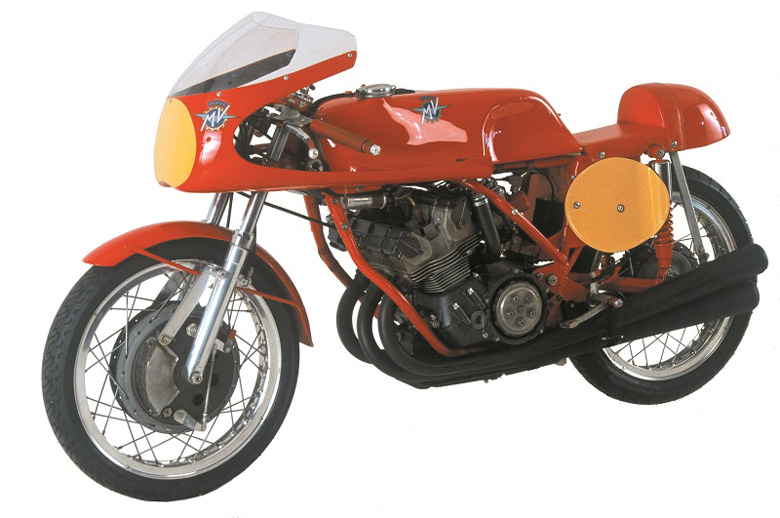
1965 MV Agusta 3 cylinder. At the Quail gathering in May of 2016, this bike won the ‘Spirit of the Show’ award – top honors from a prestigious event.
One of those museums is the Solvang Motorcycle Museum, founded by Virgil Elings, who is from Iowa himself (Des Moines). Elings has about 150 bikes, of which about 80 are on display in the museum. To get right to the point, this is one of the finest motorcycle museums in the world, period. Elings is focused on acquiring, restoring, and displaying the rarest and most desirable bikes ever made.
He is a focused individual. He has an S.B. in Mechanical Engineering from Iowa State University, a Ph.D. in physics from M.I.T., and holds more than forty patents. When he was graduated in physics from M.I.T. he went to teach at UC Santa Barbara, which he did for 20 years. He has an entrepreneurial spirit, and so while on leave in 1987, he created his own company, called Digital Instruments, Inc. He manufactured the first commercially available scanning probe instruments, some of them costing as much as a million dollars. One of these is called the “Scanning Tunneling Microscope,” which can magnify objects 10-20 million times. It gave researchers the ability to see atoms for the first time!
There is a rumor that Elings rode his motorcycle up and down the Infinite Corridor at M.I.T. When asked about this, he replied, “Early in my life, motorcycles were a source of freedom. Now I collect them because I enjoy the diversity of engineering. No relation to high energy physics, and there doesn’t need to be either.” He adds, “I buy bikes that I think I’ll never see again.” I think this one sentence summarizes the entire focus of the collection. He bought one bike, the 1913 Thor, from a family which had owned it for 100 years! The other focus is race bikes. Virgil and his son did some vintage bike racing at Sears Point, Willow Springs, Albuquerque, Las Vegas, and Steamboat Springs. Virgil did well in the “over fifty” age category of motocross. He took up road racing, where there are no age classes, and gave it up when he reached 60. His advice was, “If you are old, you should stay on the same bike, so if you get a panic attack you know just what to do!”
Elings acquired his first bike, a 1939 James 125, when he was 14. It kept breaking down, so he had to learn to fix it. (This reminds me of the saying, “Every part that falls off this bike is of the very highest British quality!”) He took machine shop at a vocational high school. This was propitious, because fixing the bike is what got him interested in mechanical engineering. In 1957, he rode a BSA Golden Flash from Iowa to California and back. (BSA means “Bastard Stopped Again”). When teaching, a friend convinced him to purchase another BSA – a Shooting Star. He was hooked.
He is passionate about the learning process, and particularly how learning inspires creativity. To that end, in recent years he has funded a program called the Dos Pueblos Engineering Academy, a 4 year program at a local high school, founded by a MacArthur Fellowship winner, which offers classes in physics, industrial design, machine shop, physics, programming, and CAD/CAM. This is an inspiring story!
As far as I can tell, Elings splits his time between philanthropy and motorcycles. This seems like an ideal life. He was able to acquire an entire shopping mall in downtown Solvang, and has re-purposed an ex-Brooks Brothers store as a museum to display the bikes. This means that, unlike all the other bike collections I have seen, it has hardwood floors and the traditional blue pin-striped Brooks Brothers wallpaper, which gives it an elegant touch. Strangely, I could not see any oil on the floor either.
When I walked in, the first bike just inside the front door I saw was a perfect replica of what I consider to be the greatest bike ever made, the Moto Guzzi V-8. After I picked myself off the floor, Elings came out to introduce himself, and I was privileged to get a tour of the collection, during which he highlighted bikes which he felt were particularly interesting and explained to me why this was the case. The thing is: they were all particularly interesting, because of Eling’s focus on the rarest bikes ever made, “the ones you will never see again!” In the case of the Moto Guzzi, only 2 bikes were left standing in 1957, and since they are owned by the factory, Virgil’s is an exact replica. It is a DOHC motor with one carburetor for each cylinder. It put out 78 h.p. at 12,000 rpm, and reached 172 mph in testing, a figure not attained by anybody else for another 20 years!
As we walked through the collection, Virgil stopped to talk and show me, specific bikes, such as:
-the Britten, one of ten made.
-the MV triple, the first one made
-the AJS 7R 350 ohc
-the Crocker
-the Brough Superior
-the 1938 DKW SS supercharged
-the 1953 NSU Rennmax world champion in 1953 and 1954
-the 1955 NSU Sportmax 250
-the Jawa 2 cylinder mystery bike with cylinders pointing up and down
-the 1959 MV dohc 125 from the factory race team
-the 1928 DKW pre-twingle 2 stroke twin supercharged
-the Velocette Mark 8 which raced he raced at Daytona (he had to make a crankshaft for it when the original weld broke)
-a 1949 Vincent Black Lightening, one of 30 made, which reached 182 mph at Bonneville
-a 1957 Gilera, the first to have an across the frame dohc four, copied by MV
-a 1974 Ducati round case 750
-the 1921 Mars 1000 with 2 drive chains
-the 1950 Vincent Gray Flash, one of 4 bikes built for the Isle of Mann, built from a pile of bits to avoid tax!
-the 1974 Aermacchi which gave Harley 4 world championships (3 for the 250 and 1 for the 350)
-the 1966 Montessa factory racer built by Walter Villa
-the 1966 Honda RC 181 factory racer, one of three; two are with Honda
-the 1922 Megola, with a five cylinder radial engine that rotates with the front wheel.
And I could go on. In the limited space of this column, I am not able to give all the special bikes their due, but fortunately, there is a way you can get this information. Last year, Quarto Publishing Group published a 224 page book on the collection, highlighting fifty spectacular bikes. Photographer Tom Loeser was given the assignment. When he got there, he called the Editor, Pat Hahn, and said, “I think you had better come up here.” The result is a spectacular book, “The Art of Speed, Classic Motorcycles.”
One of the most interesting things about the book is how Loeser does the photography, which he calls “light painting.” To perhaps oversimplify, he locks he camera in place on a tripod, focuses it, and sets the exposure. The room is dark; he carries the lighting in his hand. He opens the shutter and walks past the bike, at a steady speed, with the light a constant distance from the bike. The shutter closes. He does this 20 or 30 times! He does not touch the camera during this, to maintain the pixel to pixel registration. One of his friends describes this as “playing 3-dimensional chess wearing a blindfold.” You must see the book to understand how this works. I have never seen this before.
The Editor, Pat Hahn, is one of the most knowledgeable people in the motorcycle community and the author of numerous books on motorcycling. He has divided the book into 3 sections: “The Experimental Years,” “Finding the Groove,” and “The Art of Speed.” His writing is comprehensive for the amount of space allocated to each bike.
In closing, I must thank Virgil Elings and his assistant Jill Ballard for making this tour possible. My recommendation is to read the book first, so you will be fully prepared for the experience. The museum is open weekends and by appointment. The website is: www.motosolvang.com. You should plan on spending at least two or three hours, at a minimum, to study the bikes, because you will need it.
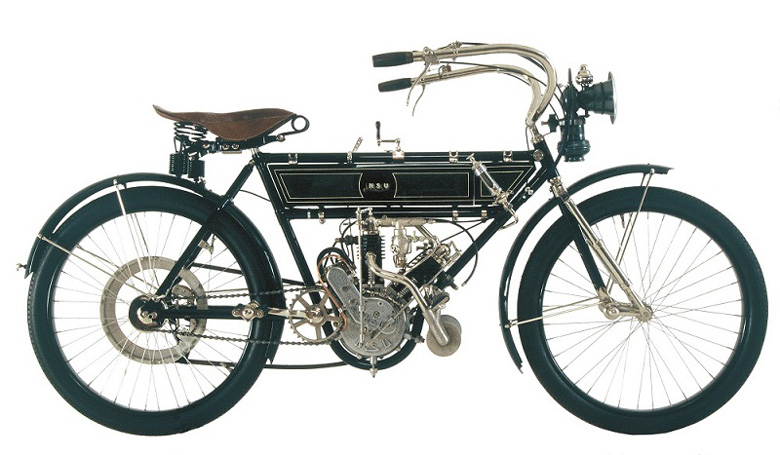
1904 NSU V Twin
NSU was a German company whose motorcycles ranked along with BMW and DKW as Germany’s most famous manufacturers. They started making motorcycles in 1900 and their racing bikes won the 250cc world championship in 1953, 1954 and 1955. NSU became involved with the rotary engine (see the rotary Norton) with Felix Wankel in the 50’s and 60’s and due to engineering difficulties, was to spell the end of NSU. They were eventually bought by Volkswagen.

1927 Henderson Four
The Henderson Brothers were the fathers of the 4 cylinder motorcycles in America. The company was bought by Schwinn (the bicycle people) and the Hendersons went on to make the ACE, which was bought by Indian.
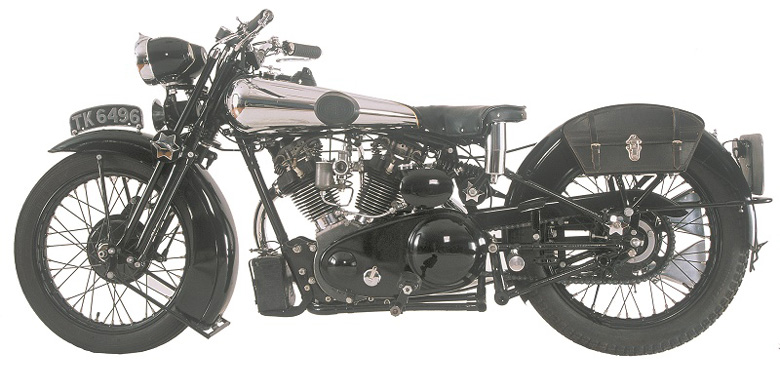
1932 Brough Superior
In the early 30’s, the best and fastest motorcycles were made by George Brough in England. Lawrence of Arabia was killed on a Brough Superior SS100. This model has a small JAP (no, not Japanese – J.A. Prestwick of England) engine – 680cc instead of 1000cc. In 1936 Vincent came out with their own V twin engine, and relegated the Brough to #2.
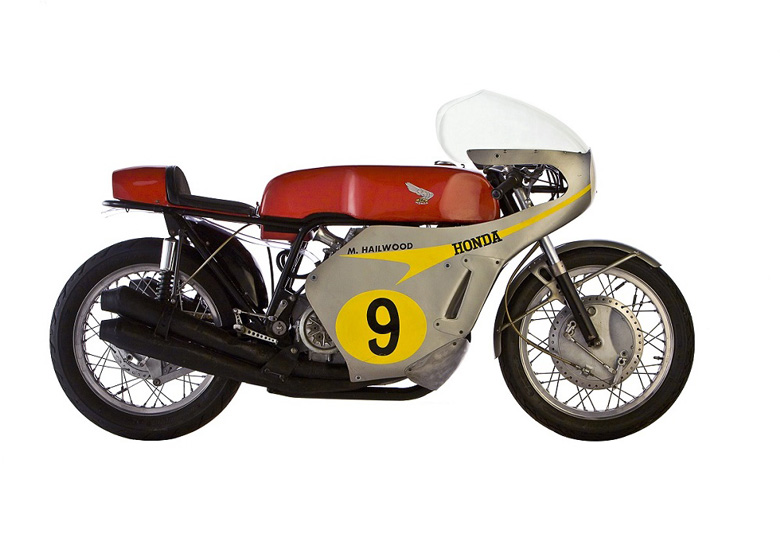
Honda RC181
500cc Factory Racer
Honda contested the 500 Gran Prix class for only two years (1966 and 1967) before they quit motorcycle racing, until 1977. This bike has the 1966 engine which retired Jim Redman from racing and went on to almost win the World Championship in the hands of Mike Hailwood. This engine probably won the 1966 Isle of Man TT. In 1967 two more engines were built and raced, and are now in the Honda Museum (there are only 3 RC 181’s). Mike hated the 500 frame, which was no match for the power of the engine and had a special frame made, which is this bike. The bike was raced 3 times in the 1968 Italian series against Agostini’s MV. In their last meeting, Hailwood beat “Ago” with this bike. I tried to get Agostini to sign “my view” on the back of the bike but he didn’t remember that being the case. I guess we remember only the good times.
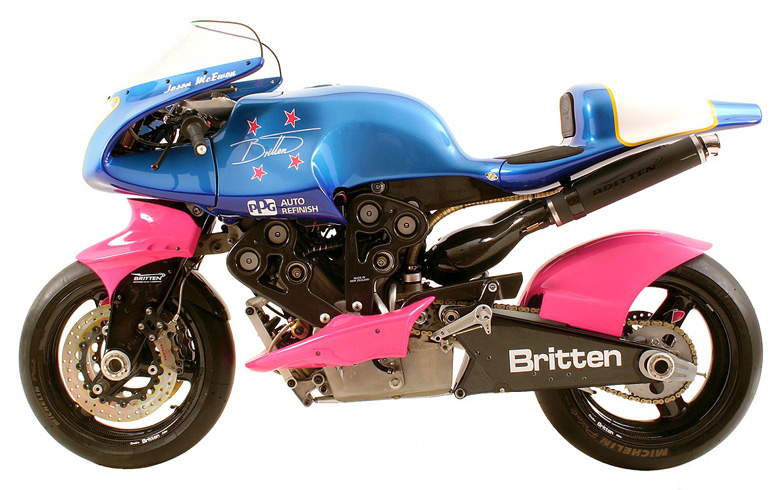
BRITTEN V1000
10 Britten motorcycles were made from scratch by a handful of New Zealand enthusiasts following the dream of John Britten. In the early 1990’s these were probably the fastest 4-stroke motorcycles in the world, able to do wheelstands at 150mph. All the body work, including the wheels is carbon fiber. This is the last Britten made because John Britten died in 1995 at age 45 and the dream died with him.
This is the only Britten that has not been raced and has been in its crate until 2004.

Great!
Fantastic piece!
Thanks!
Truly a great museum, especially if you like race bikes.
Fabulous collection indeed !
Most surprising machine was the 250cc NSU Rennmax
which Werner Haas rode to be champion at age 46. Those
motorbikes were so superior then and their firm largest
producer of motorcycles then.
Seems to me they were still competitive later in private hands.
Jim sitz